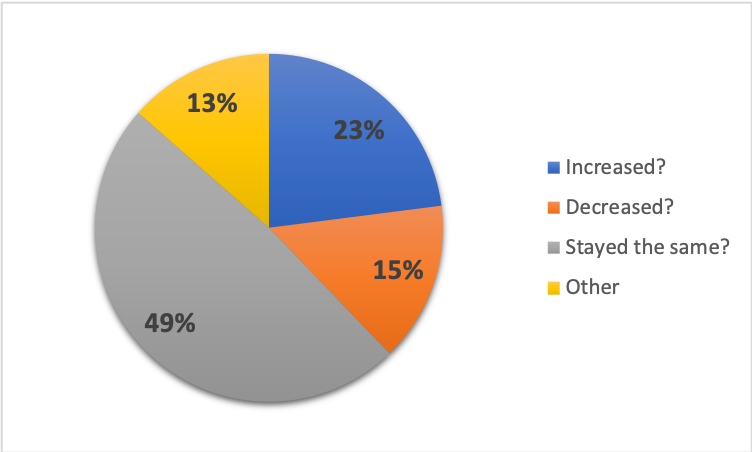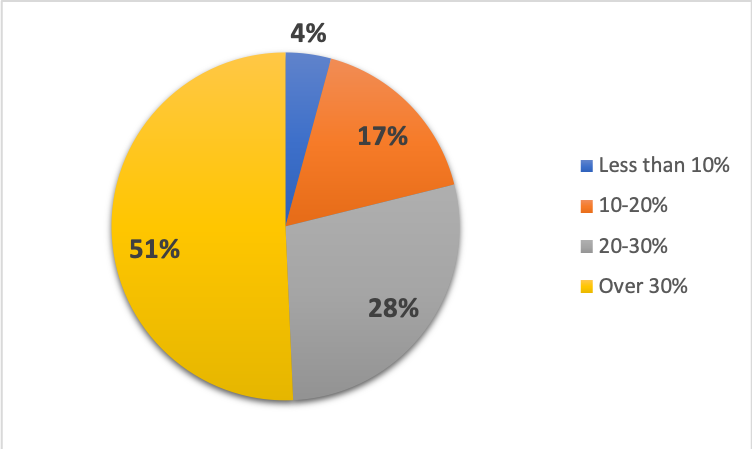April 8, 2020 — The coronavirus crisis has forced publishers to move rapidly to reduce print-related costs and transition their business models to more digitally-dependent news and information platforms.
That’s one of the clearest conclusions from the results of a Cribb, Greene & Cope Coronavirus Survey of newspaper owners and publishers released today. Seventy-six newspaper executives from across the country participated in the survey.
The COVID-19 crisis is pushing newspaper executives to take unprecedented measures to ensure their sustainability and relevance in a post-pandemic world. Nearly 50% of the survey respondents are projecting ad revenue declines of 30% or more in the second quarter of this year.
“Best to make dramatic cuts now rather than slowly,” one survey respondent said. “Focus on digital first and push everything through social media.”
Several advised colleagues to use the crisis as a time to strengthen relationships with advertisers and readers. “Do everything you can to show that you support local businesses owners,” one said.
To offset top line revenue losses, newspaper executives are:
- Aggressively reducing expenses by cutting page counts, single-copy circulation, eliminating TMC products and reducing publication day(s).
- Creatively reducing payroll expense by a mix of furloughs, hourly reductions, and some permanent layoffs.
- Quickly applying for SBA loans or other forms of government financial assistance – 85% of respondents said they had applied or plan to apply.
- Beginning a marked industry-wide transition from free on-line local news to digital paywalls.
The coronavirus crisis is accelerating newspaper executives’ plans to “right-size” staffing, capture more digital revenue, and transition to subscription based revenue models.
The Cribb, Greene & Cope team wants to thank all participants in our coronavirus survey. Here are the individual results of the survey:
1. Have you adjusted print frequency in the short term?
Fifty-four percent of respondents indicated that they do not plan to change their print frequency in the short term. The other 46% are cutting at least one day, or going to a digital-only strategy.

2. Do you believe your publication frequency reductions will be permanent?
Of the respondents that have or plan to change print frequency, 58% believe the reductions will not be permanent, while 42% plan to keep frequency at the reduced level for the foreseeable future.

3. Has paid print circulation: increased, decreased or stayed the same?
Nearly half (46%) of executives surveyed said that their paid print circulation has stayed the same. Twenty-three percent have seen an increase in paid print circulation.

4. Has paid digital circulation/traffic: increased, decreased, stayed the same?
Seventy percent of newspaper executives who responded said that their paid digital revenue has increased since the crisis broke.

5. Do you anticipate a revenue decrease in Q2 (April-June) and if yes, by how much?
Our purpose in asking this question was to gauge the short-term effects of the pandemic thus far. Fifty-one percent of respondents indicated that they expect at least a 30% decline in revenue for Q2. Only 4% said they expect no revenue decreases.

6. Do you anticipate a revenue decrease in Q3 (July-Sept.) and if yes, by how much?
Our purpose in asking this question was to gauge the mid-term effects of the pandemic this year. Thirty-two percent of respondents indicated it is unclear at this time, while 48% expect a decrease between 0-20%.

7. Do you anticipate a revenue decrease in Q4 (Oct.-Dec.) and if yes, by how much?
Our purpose in asking this question was to gauge the longer-term effects of the pandemic this year. One third of respondents said that it is unclear at this time.

8. Have you reduced payroll?
Seventy-one percent of those surveyed responded yes.

9. If you have reduced payroll, by how much?
Most newspaper executives (40%) have reduced payroll by 10-20%.

10. What method(s) have you used to cut payroll (select all that apply)?
Respondents are utilizing a mixture of payroll reductions evenly spread between permanent layoffs (42%), short term mandatory furloughs (42%) and temporary reductions in wages (39%).

11. Have you seen an increase in unpaid receivables?
Sixty-two percent of respondents have seen an increase in unpaid receivables.

12. What methods have you employed to reduce newsprint consumption?
Half of respondents (50%) have reduced per-issue page count while 24% have cut copies for bulk sales, NIE, single-copy, etc. Thirteen percent have eliminated TMC products.

13. Have you applied for SBA loans or other forms of government financial assistance?
Eight-five percent of newspaper executives have applied or plan to apply for government assistance.

14. How have you approached the coverage of Covid-19 pandemic in your newsroom?
The following are some comments/suggestions from survey respondents:
- “Our editorial team is working remotely as much as possible.”
- “We are relying more on websites and social media.”
- “We write an update every week from interviewing local leaders and medical staffs, with an emphasis on timely digital coverage and in-depth print coverage.”
- “Maintained staffing levels for the time being (March-April). Will likely need to adjust in May/June. Dropped paywall initially for all web stories; adjusting now to just COVID stories as a public service.”
- “Trying to look at it from all angles: health, education, local businesses, tourism and event effects, agriculture, natural resources. Bringing in local health experts to do live video interviews.”
- “It’s all C-19 coverage all the time. People are talking about nothing else. We’re a weekly, with a robust web site, and we strive to be first on all local C-19 stories. Reaction has been huge.”
- “Human interest stories. Focus on the good news of our communities. Running a travel series of two local men who spent a month traveling southeast Asia doing research for a novel. Great opportunity and readership for people stuck in their homes.”
- “Our city government has paid to mail the newspaper to all households for two weeks. About 2/3 of our news hole is going to COVID-19 coverage. We are supplementing the weekly print product with daily online stories.”
- “Heavy use of social media platforms for breaking news and health alerts; full staff devoted to first-person reaction/perspective stories; trying especially hard to write feel-good local human-interest stories that have nothing to do with COVID to give community some good news.”
15. What suggestions do you have for fellow publishers to weather this crisis?
The following are some comments/suggestions from survey respondents:
- “Find savings where possible. Grab any revenue dollars-think John Paton’s statement stacking digital dimes but apply to print and digital; stack coronavirus dimes to match pre-coronavirus dollars. Anywhere we find a dollar. This may mean rate reductions, BOGOs, etc. Above all, though, try not to arrive at a permanent solution to a temporary problem.
- “Hang on to cash if possible.”
- “Cut expense, reduce print frequency, better train for digital sales.”
- “This is a day at a time crisis. Have a longer-term strategy for general guidelines but be willing to alter it on the fly. Push your best people to think and voice opinions on strategy. Work with a high sense of urgency. Be as productive as you can with each of the days, make sure to plan the next, then put it away and get some sleep. You need it.”
- “Don’t be afraid of having conversations with your local edc, main street and businesses about us needing their financial support if we are to remain in business. We have discounted our rates for advertisers wanting to let people know they are open or if they have changed the way they are doing business. We are having success with this strategy.”
- “Develop better digital niche products.”
- “Provide GREAT journalism for your communities.”
- “Move to digital thinking on subscriptions and advertising. You may only have subscriptions to support your newspaper and will need digital to drive new subscribers and attract advertising.”
- “Best to make dramatic cuts in expenses now rather than slowly bleed out later. Focus on digital first and push everything through social media. Don’t be afraid to ask for donations from readers (we are doing via TownNews’ Support Local Journalism service.”
- “Do everything you can to show that you support your local business owners. We have three different directories of local businesses that give every local business that wants a listing a free listing. Once a day, we put those back to the top of our home page.”
- “Maintain your staff as long as you can. We are negotiating with lenders about going to interest-only payments for six months and looking to reduce costs – especially printing and postage – as much as possible.”
- “This is a new coverage area and one that will be remembered long after things clear up. All coverage will be historical.”
